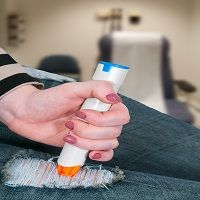Anaphylaxis Plagues More Adolescents than Children, Survey Finds
New research indicated adolescents are twice as likely as younger kids to suffer from anaphylaxis and other severe allergic reactions while they are in school.

New research indicated adolescents are twice as likely as younger kids to suffer from anaphylaxis and other severe allergic reactions while they are in school.
A study team, which presented its findings during the annual meeting of the American Academy of Allergy, Asthma & Immunology, surveyed 6,001 schools that participated in the EpiPen4Schools program about the frequency of anaphylaxis in both students and employees during the 2013-2014 school year.
The responding schools included 2,146 elementary schools with students from pre-K to grade 5, 703 middle schools with students from grade 6 to grade 8, 1,064 high schools, and 2,088 with other grade combinations.
The total number of anaphylactic events, 724, equaled slightly more than 1 severe reaction for every 10 schools, but events were not evenly distributed. Not even close.
Nearly 50% of all the students who experienced anaphylaxis were in high school, while 32% were in grade school and 19% were in middle school.
The finding was counterintuitive given that many children outgrow allergies as they move into adolescence, but Martha V. White, MD, a study co-author from the Institute for Asthma and Allergy in Wheaton, MD, offered several possible explanations.
Teenagers have considerably more freedom than younger kids to choose food for themselves, either by selecting among options at the school cafeteria, using vending machines or (at many high schools) going out for lunch. Adolescents are, therefore, far more likely to sample unfamiliar fare and, on occasion, suffer from allergic reactions.
Indeed, food was the clear trigger for 64% of all cases of student anaphylaxis reported by the high schools and also the trigger in some (and probably most) of the 22% of all events that were unexplained. Medications and other chemicals, meanwhile, were the likely triggers for 7% of the cases of high school student anaphylaxis, while insect bites and stings were the likely trigger for 6% of them.
For those students who did suffer from anaphylaxis, no matter what their age, help was often difficult to find.
All of the schools that participated in the survey had epinephrine auto injectors (because they all participated in the program that gives such tools to schools), but many placed severe restrictions on the use of the devices.
Approximately 36% of all the schools (n=2,022) only trained nurses and “select staff” to recognize anaphylaxis. Another 29% (n=1,621) trained “most staff” and 31% (n=1,730) trained all staff.
That said, 54% of all schools permitted only nurses and other select staff to actually administer epinephrine, while 16% of all schools allowed most staff members to administer shots, and 22% allowed all staff members to administer shots. The survey did not indicate how many schools, if any, allowed children to carry and use their own autoinjectors.
“Some students encounter staff members who are untrained in anaphylaxis recognition or treatment,” the study authors wrote. “These findings suggest a need for continued anaphylaxis training for protection of all students, staff, and visitors.”
The new study, in finding that high school students suffer from more anaphylaxis incidences despite lower rates of allergies, suggested that adolescents also need more anaphylaxis training.
Other recent studies have reached exactly the same conclusion. Research from Britain, for example, just found that only 16% of all teens with diagnosed allergies routinely comply with the guidance they receive from doctors. Researchers in Canada, meanwhile, have found that a significant portion of teens there believe they could “sleep off” anaphylaxis rather than treating themselves with epinephrine.